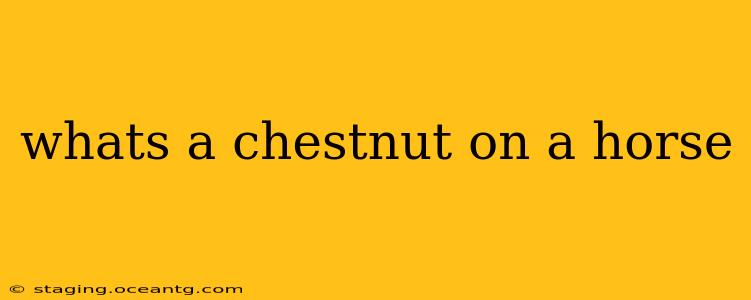What's a Chestnut on a Horse? Understanding Equine Markings
A chestnut on a horse refers to a dark brown or reddish-brown marking found on the horse's legs. These markings are distinctive and are often used to identify individual horses, much like a fingerprint. Unlike other markings which can vary in size and shape, chestnuts are typically small, round or oval patches of pigmented skin. They're often described as "ergot" when they are located on the fetlock (the joint above the hoof) and "chestnut" when found on the inside of the leg, higher up.
While seemingly insignificant, chestnuts hold a unique place in equine anatomy and identification. Let's delve deeper into some frequently asked questions surrounding these fascinating markings:
What are chestnuts and ergots on a horse?
As mentioned, chestnuts and ergots are essentially the same type of marking, differing only in location. Chestnuts are found on the inside of the legs, typically on the fetlock joint (although they may be higher up), while ergots are found on the back of the fetlocks, almost like a small, hardened growth of skin. Both are composed of keratin, the same protein that makes up hooves and horns.
Are chestnuts and ergots always present on a horse?
No, not all horses have chestnuts and ergots on all four legs. Their presence, number, and size can vary significantly between breeds and even individual horses. Some horses might have them on only two legs, others on all four, and still others might have none at all. The absence or presence of these markings doesn't affect the horse's health or performance.
What is the purpose of chestnuts and ergots?
This is a question that has puzzled equine scientists for years. While a definitive answer remains elusive, there are several theories:
- Rudimentary remnants: Some believe they are vestigial remnants of the dewclaws found on other mammals. These dewclaws served a purpose in locomotion and gripping, but over evolutionary time, they became unnecessary for horses and essentially disappeared, leaving behind the chestnuts and ergots.
- Protection: Others suggest they might offer some protection to the sensitive areas of the legs, though this theory lacks concrete evidence.
- Grip: Some believe that their slightly rough texture might provide a small amount of extra grip, particularly on slick surfaces. Again, this requires further research.
In essence, the precise function of chestnuts and ergots remains a subject of ongoing study and debate within the equine scientific community.
Can chestnuts and ergots be removed?
While it's technically possible to remove chestnuts and ergots, doing so is generally not recommended. They are part of the horse's natural anatomy, and attempting removal could lead to injury, infection, or unnecessary discomfort. Moreover, they can serve as useful identification features.
How are chestnuts used in horse identification?
While not a primary identification method, chestnuts (along with ergots, white markings, and other unique characteristics) can contribute to a more comprehensive description of a horse. Their size, shape, location, and presence or absence on each leg can be noted in detailed descriptions or identification documents, adding to the overall uniqueness of an individual horse.
In conclusion, chestnuts on a horse are intriguing, distinctive markings with an evolutionary history that continues to spark scientific curiosity. Understanding their characteristics and potential roles adds to our appreciation of these magnificent animals.
